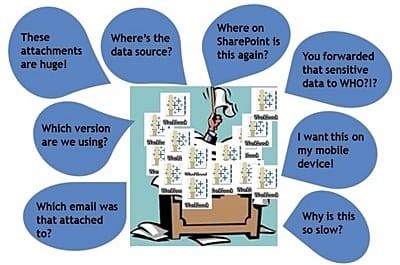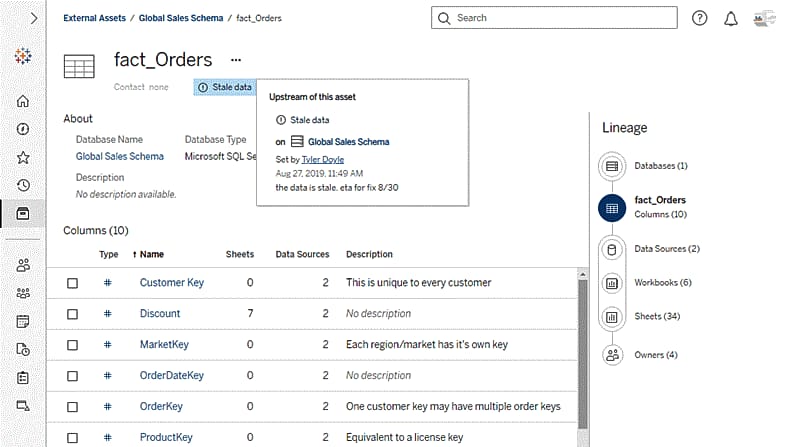In order to scale Tableau to the enterprise and achieve true self-service capabilities for your organization, you need to add Tableau Server to your environment. Tableau Server provides data governance, centralized data management and much more. Tableau Server really takes your Tableau environment to the next level.
What can be a little tricky is that Tableau Server and Tableau Desktop development environments are nearly identical. It brings up lots questions: What does that mean for report and dashboard development? Should you use Tableau Desktop or Tableau Server? So what is the difference between these two products?
In this blog we will outline differences between the two products and help you answer the following questions:
- When is it time to bring in Tableau Server?
- What are the differences between the Tableau Server and Tableau Desktop?
- What are the licensing requirements?
Learn Tableau. Expert instructors. Advanced topics.
When is it time to bring in Tableau Server?
If your environment resembles the above image, it is time to rein in the uncontrolled growth and introduce Tableau Server to the mix.
Three primary scenarios trigger the need for Tableau Server:
- You have a high growth, uncontrolled environment – and you want more security, collaboration, governance and performance.
- You want to reign in the number of data sources being used along with the proliferation of dashboards and workbooks, each with their own metadata layers, extracts and copies.
- You want to take advantage of Tableau features that are only available in Tableau Server.
What are the differences between Tableau Desktop and Tableau Server?
Tableau Desktop is installed on a workstation or laptop. Tableau Server is installed on a Windows or Linux server and is accessible to users via a browser.
Both Tableau Server and Tableau Desktop allow you to create, modify and share Tableau workbooks, dashboards and worksheets. Today Tableau Server’s (browser-based) web authoring environment has nearly every feature that is available in Tableau Desktop.
BUT, there are a few capabilities that are unique to each. Differences between Tableau Desktop and Tableau Server fall into these categories
- Collaboration
- Mobile support
- Security
- Functionality in the authoring environment
- Scalability/performance
- New features only available in Tableau Server/Tableau Online
Collaboration – In Tableau Server’s web authoring environment users can create, edit, and publish workbooks and data sources without the need for Tableau Desktop. The published workbooks can be shared and modified by authorized users. This functionality allows organizations to move closer to the holy grail of self-service analytics. Once data sources and workbooks are published to Tableau Server they can be organized and consolidated under projects where they can be centrally managed, eliminating the error-prone procedure of emailing workbooks and links.
Mobile applications – Tableau Desktop 2020 release includes more options to create device-specific layouts.
In Tableau Server release 2020 you can create device specific layouts for desktops, tablets or phones as well but they are relatively generic. Modifications of device specific layouts created in Tableau Server will need to be done in Tableau Desktop. If you want a particular device model you will need to use Tableau Desktop (see above). Once you create a phone layout it can be accessed via the Tableau Mobile app. The Tableau mobile app requires Tableau Server.
NOTE: For more information on publishing using Tableau mobile and other methods see our blog: Six 6 Ways to Publish & Share Tableau Content.
Security – Tableau Server can be used to manage access to published content to help protect sensitive data. Within Tableau server administrators can create groups and grant permissions on projects, workbooks, views and data sources. Security can be managed at a very granular level within Tableau Server.
For example, you can specify if users can download or edit worksheets or only view them. If you need to restrict data by user (row-level security) there are multiple ways to enforce this. Some methods require Tableau Server and some require Tableau Desktop, for more details see our blog: Securing and Filtering Data by User in Tableau.
Functionality in the authoring environment – Tableau Server and Tableau Desktop each offer a rich Tableau development/authoring environment. They are very similar in terms of development functionality, but there are a few differences
-
- Data source editing is limited in Tableau Server. You can only edit some information. For example, in Tableau release 2020 you still cannot edit joins or relationships within Tableau Server’s web authoring environment. As an alternative, you can use Tableau Prep (Prep is a Tableau ETL tool similar to Alteryx). Tableau Prep is available within the browser in versions 2020.4 and above.
- Tableau Desktop provides some analytic capabilities not found in Tableau Server’s web authoring environment. What is available depends on the version of Tableau Server. For a complete list of capabilities by version see Tableau’s Web Authoring and Tableau Desktop Feature Comparison.
- As of Tableau version 2020.4, formatting options are more limited in Tableau Server. You cannot format at the item or worksheet level, only at the worksheet level.
- Custom color palettes. To create a custom categorical, diverging or sequential color palette, you need to modify the Tableau preference file, which is only available from Tableau Desktop. Once you have assigned the new color palette to dimensions and measures, you can publish the data source to Tableau Server. After published, the custom colors are available to any workbook that uses that data source – but you need to start with Tableau Desktop. NOTE: There are version-specific differences in Tableau Server web authoring. View a comprehensive list of the features added in each release of Tableau Server.
Scalability/performance – When you incorporate Tableau Server you can add more servers to handle user load. Tableau Server also includes license views to provide visibility into use. These views allow you to understand users’ analytic needs, adjusting the mix to drive down costs and to ensure all licenses and content are being used. You can’t get this type of use visibility and scalability without Tableau Server.
New features only available with Tableau Server/Tableau Online – Tableau’s focus on Tableau Server is apparent when you look at many of its cool new features. Subscriptions, Metrics, Ask Data (Natural Language query support) and Tableau Mobile are only available with Tableau Server. Tableau Server also provides optional add-ons like Tableau Catalog, which allows users to “certify” data, check lineage and perform impact analysis.
Note: Tableau Catalog is available in 2019.3 and above and is an additional $5.50 per user per month. See below for an image of Tableau Catalog
Licensing requirements of Tableau server and Tableau Desktop
Tableau Desktop, Tableau Server and Tableau Prep all come with the Tableau Creator license. If you are happy to do all development from the browser, there is a lower cost alternative: Tableau Explorer. With the Explorer license, you can still create and edit workbooks using previously published data sources.
For more details about Tableau licensing see our blog on Tableau licensing. And for more details about Tableau Prep see our on-demand webinar.
Conclusion
You can see that Tableau Server vs. Tableau Desktop is not an either/or situation. Both products complement each other and provide their own unique features. But as your Tableau journey continues and you want to incorporate centralized management, mobile support and have access to great new features such as Ask Data, it is time to incorporate Tableau Server. If you are content to create workbooks for personal use and share your work via attachments, Tableau Server may not be an absolute requirement yet. We hope this blog with details of what is and isn’t in each product will help you decide if it’s time for you to incorporate Tableau Server.
At Senturus, we understand that installing and properly configuring Tableau server can be a daunting task and is not for the faint of heart. We are here to help! We have installed and upgraded many Tableau servers and will help you get the most bang for your Tableau buck. We will make sure Tableau Server is installed correctly to meet your requirements and set you up for success down the road.
If you have any questions or want to chat about installing or upgrading Tableau Server contact us. Our Tableau consulting services help clients successfully transition to a nimble, large-scale application of Tableau.
For more practical insights about Tableau Server, catch our on-demand webinar on Scaling Tableau to the Enterprise: The Perks and Pitfalls of Tableau Server.





